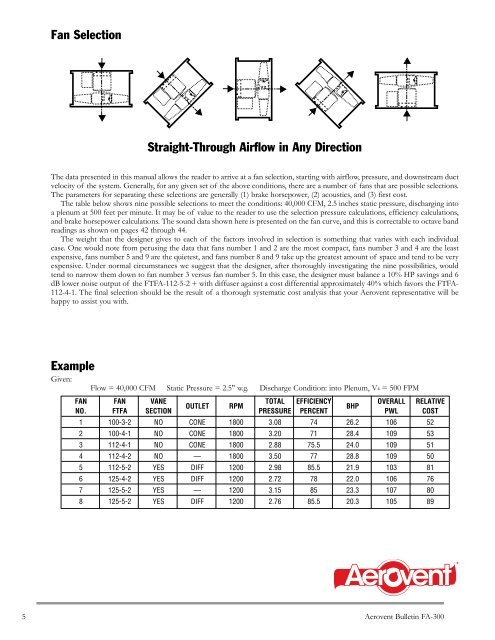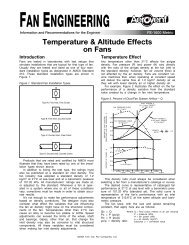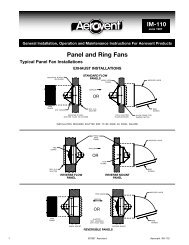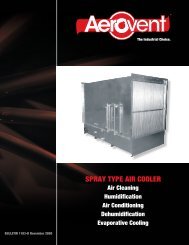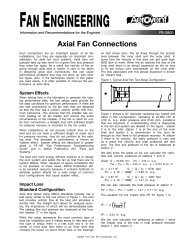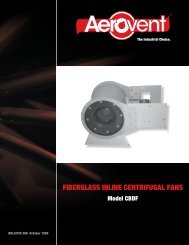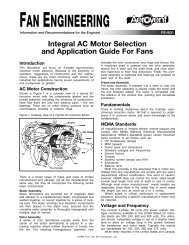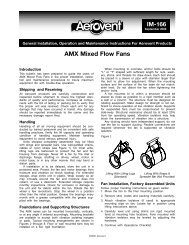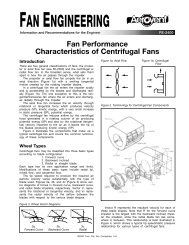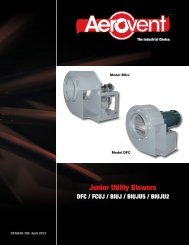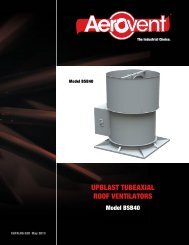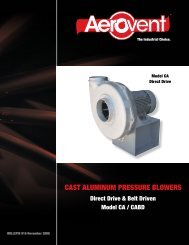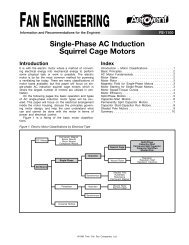Vaneaxial Fans Axiad II Adjustable Pitch Airfoil (Model ... - Aerovent
Vaneaxial Fans Axiad II Adjustable Pitch Airfoil (Model ... - Aerovent
Vaneaxial Fans Axiad II Adjustable Pitch Airfoil (Model ... - Aerovent
You also want an ePaper? Increase the reach of your titles
YUMPU automatically turns print PDFs into web optimized ePapers that Google loves.
Fan SelectionStraight-Through Airflow in Any DirectionThe data presented in this manual allows the reader to arrive at a fan selection, starting with airflow, pressure, and downstream ductvelocity of the system. Generally, for any given set of the above conditions, there are a number of fans that are possible selections.The parameters for separating these selections are generally (1) brake horsepower, (2) acoustics, and (3) first cost.The table below shows nine possible selections to meet the conditions: 40,000 CFM, 2.5 inches static pressure, discharging intoa plenum at 500 feet per minute. It may be of value to the reader to use the selection pressure calculations, efficiency calculations,and brake horsepower calculations. The sound data shown here is presented on the fan curve, and this is correctable to octave bandreadings as shown on pages 42 through 44.The weight that the designer gives to each of the factors involved in selection is something that varies with each individualcase. One would note from perusing the data that fans number 1 and 2 are the most compact, fans number 3 and 4 are the leastexpensive, fans number 5 and 9 are the quietest, and fans number 8 and 9 take up the greatest amount of space and tend to be veryexpensive. Under normal circumstances we suggest that the designer, after thoroughly investigating the nine possibilities, wouldtend to narrow them down to fan number 3 versus fan number 5. In this case, the designer must balance a 10% HP savings and 6dB lower noise output of the FTFA-112-5-2 + with diffuser against a cost differential approximately 40% which favors the FTFA-112-4-1. The final selection should be the result of a thorough systematic cost analysis that your <strong>Aerovent</strong> representative will behappy to assist you with.ExampleGiven:Flow = 40,000 CFM Static Pressure = 2.5" w.g. Discharge Condition: into Plenum, V4 = 500 FPMFAN FAN VANETOTAL EFFICIENCYOVERALL RELATIVEOUTLET RPMBHPNO. FTFA SECTION PRESSURE PERCENT PWL COST1 100-3-2 NO CONE 1800 3.08 74 26.2 106 522 100-4-1 NO CONE 1800 3.20 71 28.4 109 533 112-4-1 NO CONE 1800 2.88 75.5 24.0 109 514 112-4-2 NO — 1800 3.50 77 28.8 109 505 112-5-2 YES DIFF 1200 2.98 85.5 21.9 103 816 125-4-2 YES DIFF 1200 2.72 78 22.0 106 767 125-5-2 YES — 1200 3.15 85 23.3 107 808 125-5-2 YES DIFF 1200 2.76 85.5 20.3 105 89®5 <strong>Aerovent</strong> Bulletin FA-300


